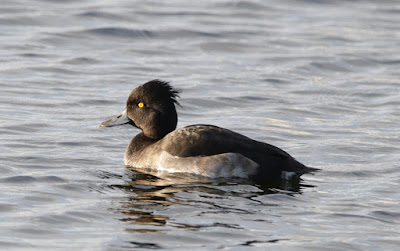Everyone is talking about the UK's cold weather. I am no exception. I have been marooned indoors in minus temperatures and icy roads for a week, a now unusual but not unknown sequence of the natural cycles of weather. This is a real old fashioned British winter; when postmen trudged through six feet of snow, milk bottles froze solid to the doorstep and trains came to a halt in snowdrifts, not because of rail strikers.
I have been trapped in our north facing away from major roads cul-de-sac where the sun don't shine and gritters never venture.
With plans for ringing and birding literally "on ice" and when standing around invited hypothermia I managed a couple of trips out Pilling way and then Knott End on Sea Ice.
At Pilling where I went to top up the supplementary seed - quick and rough counts of 30 Shelduck, 40 Teal, 50 Mallard, 180 Wigeon, 45 Lapwing, 40 Curlew and 15 or so Redshank.
Of the small birds I found 10 or more Skylarks and 5 Meadow Pipits braving the elements but nothing else save for Blackbirds, Robins, Reed Buntings, Chaffinches, Dunnocks and a few Blue Tits. All were busy inspecting and devouring our offerings of millet, rape seed, niger and Luxury Picnic Mix. Moorhens, forced off the frozen water, joined in the feast.
Dunnock
Blue Tit
On a good bright morning I reckoned to have better luck with the tide and waders at Knott End where the ice and semblance of snow covered the beach, foreshore, walkways and the jetty. It didn’t take long to find a good but not especially numerous selection of waders either roosting or feeding, but I was careful not to disturb them nor venture too far onto the treacherous icy surfaces.







For the record my counts were 30 Turnstone, 1 Grey Plover, 48 Redshank, 22 Knot, 14 Ringed Plover and 3 Oystercatcher.
A few Shelduck in amongst the ice floes sailed past the end of the jetty, as they looked for food at the tide edges.

Also along the foreshore were the now annual visitors, approximately 45 Twite and a single Rock Pipit.







































































